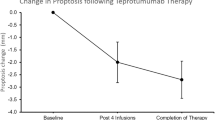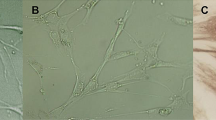Abstract
Background
To determine the correlation between clinical activity scores (CAS) of thyroid-associated ophthalmology (TAO) patients and their locally produced and/or systemically circulating insulin-like growth factor-1 (IGF-1), and to assess the possible pathogenic role of IGF-1 in TAO.
Methods
Eighteen patients with TAO, and 16 age- and gender-matched controls were included in the present study. Among them, orbital tissue surgically collected from five TAO patients and five healthy controls was used for orbital fibroblasts (OFs) culture and in vitro study. Total and free IGF-1 in serum levels were determined by an ELISA kit for all the participants in this study. The IGF-1 concentration in culture media of OFs was determined using a noncompetitive time-resolved radioimmunoassay kit. The effect of octreotide (OCT), a somatostatin analog, on proliferation of OFs was assessed using the MTT assay. IGF-1 mRNA levels were measured by real-time polymerase chain reaction (PCR).
Results
Cultured OFs from both TAO patients and normal donors secreted IGF-1, and the secretion continued over a 72 hour period in vitro. IGF-1 secretion by OFs was elevated in the TAO group. Both the elevated secretion of IGF-1 and proliferation of OFs from TAO patients could be inhibited by OCT. Result of quantitative PCR showed that IGF-1 mRNA expression by OFs in TAO patients was up-regulated more than 2-fold compared with normal controls (P < 0.05), and this up-regulation was prevented by OCT treatment. Total and free serum IGF-1 levels in TAO patients were similar to those of normal controls. However, the IGF-1 level in cultured medium of OFs from TAO patients, but not serum levels of IGF-1, was positively correlated with CAS (r = 0.97, P = 0.017).
Conclusions
Local production of IGF-1 by cultured OFs may be positively correlated with CAS, whereas systemically circulating IGF-1 may remain unchanged in TAO patients. Thus, locally produced IGF-1 may develop a role in the pathogenesis of TAO in an autocrine or paracrine fashion. The inhibitory effect of OCT on proliferating and IGF-1 mRNA levels of cultured OFs from TAO patients may be used as the mechanistic explanation for somatostatin analog as a valuable option in the treatment of TAO.




Similar content being viewed by others
Abbreviations
- IGF-1:
-
insulin-like growth factor-1
- OFs:
-
orbital fibroblasts
- TAO:
-
thyroid-associated ophthalmopathy
- OCT:
-
octreotide
- PCR:
-
polymerase chain reaction
- GD:
-
Graves’ disease
- CAS:
-
clinical activity score
- PUMCH:
-
Peking Union Medical College Hospital
- MTT:
-
tetrazolium salts
- ANOVA:
-
analysis of variance
- TSH:
-
thyroid-stimulating hormone
References
Zapf J, Schmid C, Froesch ER (1984) Biological and immunological properties of insulin-like growth factors (IGF) I and II. Clin Endocrinol Metab 13:3–30
Baxter RC, Brown AS, Turtle JR (1979) Decrease in serum receptor-reactive somatomedin in diabetes. Horm Metab Res 11:216–220
Burch HB, Wartofsky L (1993) Graves' ophthalmopathy: current concepts regarding pathogenesis and management. Endocr Rev 14:747–793
Jacobson DH, Gorman CA (1984) Endocrine ophthalmopathy: current ideas concerning etiology, pathogenesis, and treatment. Endocr Rev 5:200–220
Bartalena L, Pinchera A, Marcocci C (2000) Management of Graves' ophthalmopathy: reality and perspectives. Endocr Rev 21:168–199
Kendall-Taylor P, Perros P (1998) Clinical presentation of thyroid associated orbitopathy. Thyroid 8:427–428
Perros P, Kendall-Taylor P (1998) Natural history of thyroid eye disease. Thyroid 8:423–425
Weetman AP (2000) Graves' disease. N Engl J Med 343:1236–1248
Bahn RS (1998) Cytokines in thyroid eye disease: potential for anticytokine therapy. Thyroid 8:415–418
Natt N, Bahn RS (1997) Cytokines in the evolution of Graves' ophthalmopathy. Autoimmunity 26:129–136
Hansson HA, Petruson B, Skottner A (1986) Somatomedin C in pathogenesis of malignant exophthalmos of endocrine origin. Lancet 1:218–219
Weightman DR, Perros P, Sherif IH, Kendall-Taylor P (1993) Autoantibodies to IGF-1 binding sites in thyroid associated ophthalmopathy. Autoimmunity 16:251–257
Lakatos P, Foldes J, Nagy Z, Takacs I, Speer G, Horvath C, Mohan S, Baylink DJ, Stern PH (2000) Serum insulin-like growth factor-I, insulin-like growth factor binding proteins, and bone mineral content in hyperthyroidism. Thyroid 10:417–423
Chang TC, Kao SC, Huang KM (1992) Octreotide and Graves' ophthalmopathy and pretibial myxoedema. BMJ 304:158
Krassas GE, Dumas A, Pontikides N, Kaltsas T (1995) Somatostatin receptor scintigraphy and octreotide treatment in patients with thyroid eye disease. Clin Endocrinol (Oxf) 42:571–580
Krassas GE, Kaltsas T, Dumas A, Pontikides N, Tolis G (1997) Lanreotide in the treatment of patients with thyroid eye disease. Eur J Endocrinol 136:416–422
Kung AW, Michon J, Tai KS, Chan FL (1996) The effect of somatostatin versus corticosteroid in the treatment of Graves' ophthalmopathy. Thyroid 6:381–384
Ozata M, Bolu E, Sengul A, Tasar M, Beyhan Z, Corakci A, Gundogan MA (1996) Effects of octreotide treatment on Graves' ophthalmopathy and circulating sICAM-1 levels. Thyroid 6:283–288
Gorman CA (1992) Classification of eye changes of Graves' disease. Thyroid 2:235–236
Daughaday WH, Parker KA, Borowsky S, Trivedi B, Kapadia M (1982) Measurement of somatomedin-related peptides in fetal, neonatal, and maternal rat serum by insulin-like growth factor (IGF) I radioimmunoassay, IGF-II radioreceptor assay (RRA), and multiplication-stimulating activity RRA after acid-ethanol extraction. Endocrinology 110:575–581
Smith TJ, Sempowski GD, Wang HS, Del VPJ, Lippe SD, Phipps RP (1995) Evidence for cellular heterogeneity in primary cultures of human orbital fibroblasts. J Clin Endocrinol Metab 80:2620–2625
Krassas GE, Pontikides N, Kaltsas T, Dumas A, Frystyk J, Chen JW, Flyvbjerg A (2003) Free and total insulin-like growth factor (IGF)-I, -II, and IGF binding protein-1, -2, and −3 serum levels in patients with active thyroid eye disease. J Clin Endocrinol Metab 88:132–135
Janssen JA, van der Lely AJ, Lamberts SW (2003) Circulating free insulin-like growth-factor-I (IGF-I) levels should also be measured to estimate the IGF-I bioactivity. J Endocrinol Invest 26:588–594
Hansson HA (1989) Aspects on growth factors in exophthalmos. Acta Endocrinol (Copenh) 21(Suppl 2):107–111
Pritchard J, Horst N, Cruikshank W, Smith TJ (2002) Igs from patients with Graves' disease induce the expression of T cell chemoattractants in their fibroblasts. J Immunol 168:942–950
Smith TJ, Hoa N (2004) Immunoglobulins from patients with Graves' disease induce hyaluronan synthesis in their orbital fibroblasts through the self-antigen, insulin-like growth factor-I receptor. J Clin Endocrinol Metab 89:5076–5080
Pritchard J, Han R, Horst N, Cruikshank WW, Smith TJ (2003) Immunoglobulin activation of T cell chemoattractant expression in fibroblasts from patients with Graves' disease is mediated through the insulin-like growth factor I receptor pathway. J Immunol 170:6348–6354
Khoo DHC, Tan YT, Fok ACK, Tan CE (1995) Octreotide in the management of Graves' ophthalmopathy—changes in insulin-like growth factor 1 levels do not predict clinical response. Am J Clin Res 4:33–42
Bauer W, Briner U, Doepfner W, Haller R, Huguenin R, Marbach P, Petcher TJ, Pless J (1982) SMS 201–995: a very potent and selective octapeptide analogue of somatostatin with prolonged action. Life Sci 31:1133–1140
Tsuzaki S, Moses AC (1990) Somatostatin inhibits deoxyribonucleic acid synthesis induced by both thyrotropin and insulin-like growth factor-I in FRTL5 cells. Endocrinology 126:3131–3138
Postema PT, Kwekkeboom DJ, van Hagen PM, Krenning EP (1996) Somatostatin-receptor scintigraphy in Graves' orbitopathy. Eur J Nucl Med 23:615–617
Wemeau JL, Caron P, Beckers A, Rohmer V, Orgiazzi J, Borson-Chazot F, Nocaudie M, Perimenis P, Bisot-Locard S, Bourdeix I, Dejager S (2005) Octreotide (long-acting release formulation) treatment in patients with graves' orbitopathy: clinical results of a four-month, randomized, placebo-controlled, double-blind study. J Clin Endocrinol Metab 90:841–848
Stan MN, Garrity JA, Bradley EA, Woog JJ, Bahn MM, Brennan MD, Bryant SC, Achenbach SJ, Bahn RS (2006) Randomized, double-blind, placebo-controlled trial of long-acting release octreotide for treatment of Graves' ophthalmopathy. J Clin Endocrinol Metab 91:4817–4824
Dickinson AJ, Vaidya B, Miller M, Coulthard A, Perros P, Baister E, Andrews CD, Hesse L, Heverhagen JT, Heufelder AE, Kendall-Taylor P (2004) Double-blind, placebo-controlled trial of octreotide long-acting repeatable (LAR) in thyroid-associated ophthalmopathy. J Clin Endocrinol Metab 89:5910–5915
Acknowledgement
We thank Dr. Fang Qi (Department of E.N.T. in PUMCH) for tissue collection and Dr. Xiaolan Lian (Department of Endocrinology in PUMCH) for the diagnosis and consultation of patients with GD and Dr. Gui-shuang Ying (The Center for Preventive Ophthalmology and Biostatistics, University of Pennsylvania Perelman School of Medicine) for biostatistics analysis. We acknowledge the help of Dr. Wenchao Song (Institute for the Translational Medicine and Therapeutics, University of Pennsylvania Perelman School of Medicine) for preparing this paper. This study was supported by the unrestricted grant from Peking Union Medical College Hospital and State Scholarship Fund (File No. 2010621116) of China Scholarship Council, Ministry of Education of the P. R. China.
Disclosure
The authors have no financial conflict of interest. The authors confirm that they have full control to all data in the study, and agree to allow Graefe’s Archive for Clinical and Experimental Ophthalmology to review data upon request.
Author information
Authors and Affiliations
Corresponding author
Additional information
Clinical trial registration: ISRCTN34713784 (http://www.controlled-trials.com/ISRCTN34713784/)
This is the first study that demonstrated locally produced IGF-1 may be involved in the pathogenesis of TAO through an autocrine/paracrine mechanism.
Rights and permissions
About this article
Cite this article
Song, D., Wang, R., Zhong, Y. et al. Locally produced insulin-like growth factor-1 by orbital fibroblasts as implicative pathogenic factor rather than systemically circulated IGF-1 for patients with thyroid-associated ophthalmopathy. Graefes Arch Clin Exp Ophthalmol 250, 433–440 (2012). https://doi.org/10.1007/s00417-011-1876-5
Received:
Revised:
Accepted:
Published:
Issue Date:
DOI: https://doi.org/10.1007/s00417-011-1876-5




